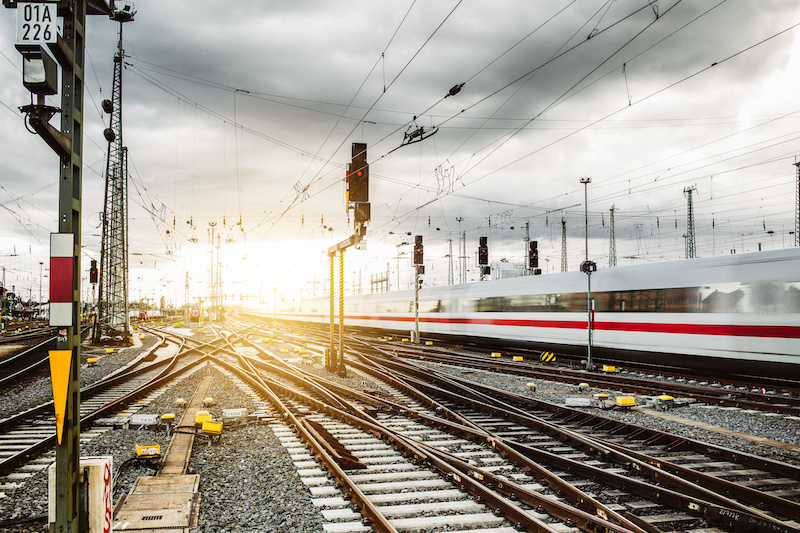

Dəmir yolu yüksək gərginlik xətləri Bölgələr və ölkələr arasında mal və insanları daşıyan dəmir yolu sistemlərinin gücləndirilməsində mühüm rol oynayın. Yüksək gərginlikli (HV) xətlər, adətən 25 kv-dan 50 kv arasında dəyişir, Elektrik qatarlarını səmərəli və etibarlı şəkildə idarə etmək üçün tələb olunan geniş miqdarda elektrik enerjisinin təmin edilməsi üçün vacibdir. Bu məqalədə, Veri kabeli yüksək gərginlikli xətlərin növlərini araşdıracaq dəmir yolu sistemində istifadə olunur, faydaları, və daha geniş infrastruktura necə uyğun olduqları.


Xüsusiyyətlərinə dalmaqdan əvvəl Dəmiryolu yüksək gərginlik xətti, Müasir dəmir yolu nəqliyyatı üçün bu cür gücün niyə lazım olduğunu başa düşmək vacibdir. Dəmiryollar, Xüsusilə elektrikləşdirilmişlər, enerji istehlakçıları yüksək tələb edir. Qədər sürətlə bir lokomotiv çalışır 300 km / h (186 mph), ağır yüklərin çəkməsi, və ya regional nəqliyyat sistemlərinin dəstəklənməsi kütləvi elektrik enerjisi tələb edir. Dəmiryol sistemləri bu tələbləri idarə etmək üçün yüksək gərginlikli xətlər ilə təchiz edilmiş xüsusi bir elektrik şəbəkəsi infrastrukturuna etibar edir.
Elektriklənmiş dəmir yollarının üstünlükləri:
Dünyadakı fərqli dəmiryol sistemləri, tarixi inkişaflar kimi amillərdən asılı olaraq müxtəlif növ elektrikləşdirmə sistemlərindən istifadə edir, infrastruktur, və xüsusi regional ehtiyaclar. Ən çox yayılmış yüksək gərginlikli sistemlərə daxildir:
Dəmir yollarının elektriklədilməsi üçün ən çox istifadə olunan sistemlərdən biri alternativ cərəyandır (Ac) elektrikləşdirmə, minimal itki ilə uzun məsafələrə elektrik enerjisini ötürmək üçün tez-tez yüksək gərginlikdən istifadə etmək.
Necə işləyir: Güc yerli bir elektrik stansiyasında yaradılır, bir transformator vasitəsilə yüksək gərginliyə qədər addım atdı, sonra ötürüldü Yüksək gərginlikli xətlər vasitəsilə dəmir yolu yarımstansiyaları. Oradan, Yerüstü kontakt xətlərinə və ya katenaj məftillərinə atılır və qidalanır.
Bəzi köhnə sistemlər və ya şəhər tranzit şəbəkələri hələ də birbaşa cərəyana etibar edir (Dc) elektrikləşdirmə. DC sistemləri AC sistemlərindən daha aşağı gərginliklərdən istifadə etməyə meyllidir, Onlar hələ də əməliyyat üçün lazım olan cərəyanın miqdarı səbəbindən yüksək gərginlik kimi təsnif edilir.
Necə işləyir: DC Systems, Catenary və ya üçüncü dəmir yolu ilə birbaşa qatarın elektrik enerjisi təchizatı, və qatarın təyyarəsi avadanlıqları bu gücü yararlı enerjiyə çevirir.
Bu tip Dəmiryolu yüksək gərginlik xətti Avropanın bir hissəsində geniş istifadə olunur, xüsusilə Almaniyada, Avstriya, İsveçrə, və İsveç. 15KV sistemi tipik güc ızgaralarından daha aşağı bir tezlikdə işləmək üçün nəzərə çarpır, dəmir yollarının ehtiyaclarına daha çox məlumat verməyə imkan verir.
Necə işləyir: Aşağı tezlik, avadanlıqların aşınmasını azaltdıqca dəmir yolu sistemləri üçün idealdır və davamlı üçün daha uyğundur, ağır yükləmə əməliyyatı.
Uzun məsafəli yüksək sürətli qatarlar ilə əlaqəli olmasa da, Üçüncü dəmir yolu elektrikləşdirilməsi bəzi dəmir sistemlərində istifadə olunan başqa bir üsuldur, Xüsusilə metro və şəhərətrafı qatarları kimi şəhər tranzit şəbəkələri.
Necə işləyir: Elektrik yolların yanında çalışan üçüncü bir dəmir yolu ilə ötürülür, hansı qatarlar bir əlaqə ayaqqabısından güc çəkir. Yerüstü katenar sistemləri qədər səmərəli olmasa da, Üçüncü dəmir yolu elektrikləşdirilməsi hələ də cərəyandan axan cərəyanın həcmi səbəbindən yüksək gərginlikli bir sistem hesab olunur.
Yüksək gərginlikli dəmir yolu sistemləri etibarlı və səmərəli fəaliyyət göstərmək üçün bir neçə əsas komponentə etibar edir. Bu komponentlər paylamağa kömək edir, pillə, və qatarlara çatdırılan gücü tənzimləyin.
Hər hansı bir elektriklənmiş dəmir yolunun ən görünən hissəsi katenardır, və ya yerüstü tel sistemi, Hansı qatarlar elektrik çəkir. Katənlik telləri yol boyunca yerləşdirilmiş masalar və ya dirəklər tərəfindən dəstəklənir və qatarın pantoqrafına yüksək gərginlikli elektrik ötürür.
Dəmiryol şəbəkəsinə qidalanan yüksək gərginlikli elektrik xətləri tez-tez Milli Grid səviyyəsindən elektrik enerjisindən aşağı addım atan yarımstansiyalardan keçir (Tez-tez yüzlərlə kilovolçu) Dəmir yolu elektrikləşdirilməsi üçün lazım olan səviyyələrə (adətən 25 kv ac və ya aşağı).
Müasir Railroad Elektrikləşdirmə Sistemləri, güc axını idarə edən qabaqcıl nəzarət və monitorinq sistemlərini özündə birləşdirir, Sabit və səmərəli əməliyyat təmin etmək. Bu sistemlər nöqsanları aşkar edə bilər, Tələbata görə enerji paylanmasını tənzimləyin, və hətta enerji istifadəsini optimallaşdırmaq üçün qatarlar ilə əlaqə qurun.
İştirak edən yüksək gərginliklərə görə, Dəmiryol elektrikləşdirmə sistemləri qəzaların qarşısını almaq və həm qatarların, həm də texniki işçilərin təhlükəsiz işləməsini təmin etmək üçün ciddi təhlükəsizlik protokollarına riayət etməlidir.
İstifadəsi dəmir yolu yüksək gərginlik xətləri qlobal bir fenomendir, Müxtəlif sistemləri xüsusi ehtiyaclarına uyğun olaraq qəbul edən çoxsaylı ölkələrlə.
Məsələn:
Yüksək gərginlikli xətlər müasir dəmiryol sistemlərinin kritik bir hissəsidir. Yüksək sürətli qatarların regional şəhərətrafı sistemlərinə qədər, Bu xətlər dünya miqyasında dəmir yolu şəbəkələrinin səmərəli və etibarlı işləməsini təmin edir. AC və ya DC istifadə, yerüstü katenary, və ya üçüncü dəmir sistemləri, Diqqətli idarəetmə dəmir yolu yüksək gərginlik xətləri davamlı gələcəyi üçün vacibdir, səmərəli nəqliyyat.
Fərqli elektrikləşdirmə sistemlərini və onların üstünlüklərini başa düşməklə, Bu infrastrukturun dəmir yollarını rəvan və nəqliyyatın gələcəyini inkişaf etdirməkdə saxlamaqda bu infrastrukturların əhəmiyyətini yüksək qiymətləndirə bilərik.
İnsanlar mineral izolyasiya edilmiş kabel termini eşitdikdə, many immediately think of harsh environments like…
Telekommunikasiya şəbəkələri və enerji ötürücü sistemləri sürətlə böyüyür, the demand for reliable and cost-effective…
Güclü neft və qaz layihələrində, Sənaye kabelləri yalnız aksesuar deyil—they are the "nervous…
Elektrik bağlantıları dünyasında, kabel qapaqları—Kabel qulaqları və ya kabel terminalları kimi də tanınır—var…
Elektrik mühəndisliyi layihəsi üçün düzgün rezin kabel seçərkən, it is critical to…
Əziz tərəfdaşlar və müştərilər: 29 yanvar, 2025 Çin Aysal Yeni ilidir – Spring…